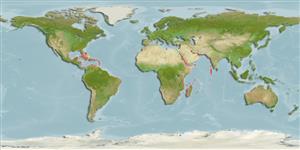Asaphis deflorata (Linnaeus, 1758)
Gaudy asaphis| Native range | All suitable habitat | Point map | Year 2050 |

|
| This map was computer-generated and has not yet been reviewed. |
| Asaphis deflorata AquaMaps Data sources: GBIF OBIS |
Classification / Names Common names | Synonyms | CoL | ITIS | WoRMS
Bivalvia | Cardiida | Psammobiidae
Environment: milieu / climate zone / depth range / distribution range Ecology
Benthic; depth range 0 - 2 m (Ref. 83435). Tropical
Distribution Countries | FAO areas | Ecosystems | Occurrences | Introductions
Western Indian Ocean and Western Atlantic.
Length at first maturity / Size / Weight / Age
Maturity: Lm ?, range 3 - ? cm Max length : 6.7 cm DL male/unsexed; (Ref. 83435); common length : 7.8 cm TL male/unsexed; (Ref. 344)
Short description Morphology
Life cycle and mating behavior Maturity | Reproduction | Spawning | Eggs | Fecundity | Larvae
Main reference
References | Coordinator | Collaborators
Berg, C.J. and P. Alatalo 1985 Biology of the tropical bivalve Asaphis deflorata (Linné, 1758). Bull. Mar. Sci. 37:827-838. (Ref. 351)
IUCN Red List Status
(Ref. 130435: Version 2025-1)
CITES status (Ref. 108899)
CMS (Ref. 116361)
Threat to humans
Human uses
Fisheries: commercial; bait: occasionally
| FishSource | Sea Around Us
Tools
More information
Diet composition
Food consumption
Predators
Max. ages / sizes
Length-weight rel.
Length-length rel.
Length-frequencies
Mass conversion
Abundance
Internet sources
BHL | BOLD Systems | CISTI | DiscoverLife | FAO(Publication : search) | Fishipedia | GenBank (genome, nucleotide) | GloBI | Gomexsi | Google Books | Google Scholar | Google | PubMed | Tree of Life | Wikipedia (Go, Search) | Zoological Record



